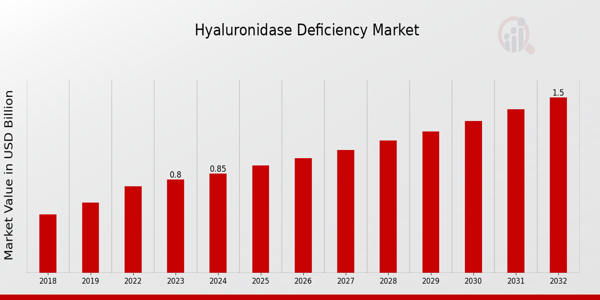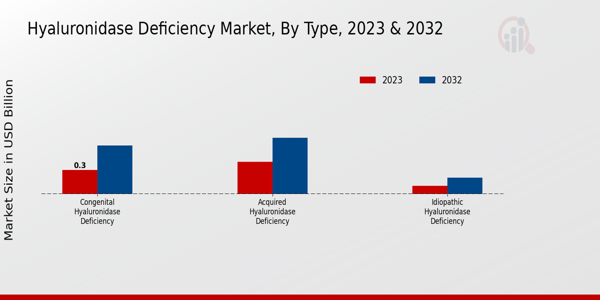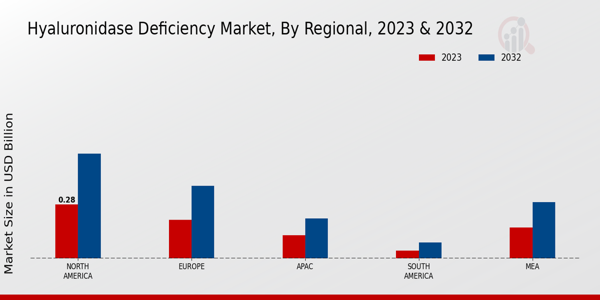Global Hyaluronidase Deficiency Market Overview
As per MRFR analysis, the Hyaluronidase Deficiency Market Size was estimated at 0.91 (USD Billion) in 2024. The Hyaluronidase Deficiency Market Industry is expected to grow from 0.98 (USD Billion) in 2025 to 1.85 (USD Billion) till 2034, at a CAGR (growth rate) is expected to be around 7.32% during the forecast period (2025 - 2034).
Key Hyaluronidase Deficiency Market Trends Highlighted
The Hyaluronidase Deficiency Market is driven by increasing awareness and diagnosis of hyaluronidase deficiency disorders. Growing research initiatives targeted at understanding the implications of these conditions contribute to a greater demand for treatments and diagnostic tools. Moreover, advancements in biopharmaceuticals and genetic therapies are enhancing the scope for effective management of these deficiencies. Additionally, rising investments in healthcare infrastructure facilitate access to necessary treatments and support systems for patients, fostering a more robust market. Opportunities in this market also present themselves through collaborative efforts among pharmaceutical companies, research institutions, and healthcare providers.These collaborations can lead to innovative drug development and improved therapeutic options. As patient perspectives gain prominence, there is a push for personalized medicine, allowing for tailored approaches in treatment strategies. The increasing number of healthcare settings focusing on metabolic disorders enhances the potential for new market entrants, creating a broader landscape for innovation. In recent times, a noticeable trend is the growing emphasis on early detection and genetic testing for hyaluronidase deficiency. This proactive approach not only aids in timely interventions but also empowers patients with knowledge of their conditions.Social media and online support groups are playing an essential role in bringing together affected individuals, encouraging discussions, and disseminating valuable information. Furthermore, the shift towards digital health solutions has accelerated, enabling remote monitoring and telehealth services, which improve access to specialists. Such trends collectively shape the future dynamics of the market, emphasizing patient-centric solutions and the integration of technology in healthcare services.

Source: Primary Research, Secondary Research, MRFR Database and Analyst Review
Hyaluronidase Deficiency Market Drivers
Increasing Prevalence of Hyaluronidase Deficiency Disorders
The rising incidence of hyaluronidase deficiency disorders is a significant catalyst for growth in the Hyaluronidase Deficiency Market Industry. With an increasing number of individuals being diagnosed with conditions related to insufficient hyaluronidase enzyme production, there is a growing demand for effective treatments and solutions that can help mitigate the impacts of this deficiency. This trend is fueled by heightened awareness and advances in diagnostic methodologies, allowing for earlier and more accurate identification of hyaluronidase deficiency disorders.As healthcare providers become more familiar with the symptoms and effects of this deficiency, the potential market for therapeutic interventions expands. Furthermore, the aging population is also contributing to this trend, as older individuals may experience a higher prevalence of enzyme deficiencies and related health issues. This demographic shift underlines the need for the development and availability of specialized treatments in the Hyaluronidase Deficiency Market Industry.With the growth of targeted therapies and potential new medical formulations, companies are increasingly investing in research and development initiatives aimed at addressing this deficiency, which can lead to improved patient outcomes and quality of life. As awareness continues to increase and the population at risk grows, the market is poised to experience significant expansion driven by the demand for innovative treatment options.
Advancements in Medical Research and Technology
The rapid advancements in medical research and technology are playing a crucial role in propelling the Hyaluronidase Deficiency Market Industry. Continuous innovations in biopharmaceuticals and enzyme replacement therapies are paving the way for new treatment modalities that can effectively address hyaluronidase deficiency. Ongoing research is exploring the genetic underpinnings of this condition, leading to promising therapeutic approaches that can enhance patient outcomes.Moreover, the development of more efficient production processes for therapeutic enzymes is also contributing to an increased supply of treatments within the market. These advancements not only enhance the effectiveness of treatments but also improve the overall safety profile, fostering greater acceptance among healthcare professionals and patients alike.
Government Initiatives and Regulatory Support
Government initiatives, combined with regulatory support, are fostering growth in the Hyaluronidase Deficiency Market Industry. Many countries are introducing policies aimed at enhancing research funding for rare diseases, which is directly benefiting the development of therapies for hyaluronidase deficiency. Regulatory bodies are also expediting approval processes for novel treatments, reducing time-to-market for new drugs. This supportive regulatory environment encourages pharmaceutical companies to invest in research and clinical trials aimed at addressing hyaluronidase deficiency, ultimately leading to a broader range of available therapeutic options.
Hyaluronidase Deficiency Market Segment Insights:
Hyaluronidase Deficiency Market Type Insights
The Hyaluronidase Deficiency Market presents a diversified structure centered around Type segmentation, encompassing Congenital Hyaluronidase Deficiency, Acquired Hyaluronidase Deficiency, and Idiopathic Hyaluronidase Deficiency. This market is projected to achieve a valuation of 0.8 USD Billion in 2023, signaling steady growth opportunities. In terms of market distribution, Congenital Hyaluronidase Deficiency holds a notable share, valued at 0.3 USD Billion, which reflects its majority holding and emphasizes its significance in patient populations, as the condition often arises from genetic factors.The Acquired Hyaluronidase Deficiency segment follows closely, valued at 0.4 USD Billion, underpinning its substantial representation in the market due to prevalent conditions that may lead to acquired deficiencies. Meanwhile, the Idiopathic Hyaluronidase Deficiency segment currently represents a smaller portion of the market with a valuation of 0.1 USD Billion, highlighting it as the least dominant category due to its less understood nature, thus posing research and treatment challenges. The overall trends indicate an increasing awareness of these conditions, driving demand for effective therapies and management options across all segments.The Hyaluronidase Deficiency Market data highlights the critical nature of treatment advancements, particularly concerning Congenital Hyaluronidase Deficiency, which often necessitates lifelong management. Meanwhile, the Acquired segment’s prominence stems from its association with various underlying medical conditions, indicating a potential for increased market growth opportunities as more patients are diagnosed. These dynamics within the Hyaluronidase Deficiency Market industry showcase how each segmentthrough its specific challenges and patient care demandscontributes to the evolving landscape of hyaluronidase deficiency treatments.Additionally, the opportunity for targeted therapies is notable in the Acquired and Congenital segments, where innovations could significantly enhance patient outcomes and thus increase market penetration. The anticipated growth rates bolster the need for enhanced research efforts, particularly focusing on Idiopathic Hyaluronidase Deficiency to understand better its implications and improve treatment options for patients facing this unique condition. Overall, the market segmentation unfolds considerable insights into patient demographics, treatment needs, and future growth potentials across these varieties, shaping the future of the Hyaluronidase Deficiency Market statistics for the coming years.

Source: Primary Research, Secondary Research, MRFR Database and Analyst Review
Hyaluronidase Deficiency Market Therapeutic Area Insights
The Hyaluronidase Deficiency Market, particularly in the Therapeutic Area segment, was valued at 0.8 USD Billion in 2023 and is expected to exhibit steady growth, reaching 1.5 USD Billion by 2032. The market growth is primarily driven by the rising prevalence of conditions related to hyaluronidase deficiency, leading to increased demand across various therapeutic areas. Key areas such as Dermatology, where hyaluronidase plays an essential role in skin conditions, and Ophthalmology, where it aids in eye-related issues, are gaining traction.Orthopedics also shows significant importance due to the necessity of hyaluronidase in treating joint disorders. Meanwhile, Oncology emphasizes the need for innovative solutions in tumor management, showcasing the versatility of this market. The overall Hyaluronidase Deficiency Market statistics reveal a healthy expected CAGR of 7.3 from 2024 to 2032, highlighting continued interest and investment in this field. However, challenges such as regulatory hurdles and the need for advanced research in the therapeutic areas persist, presenting both challenges and opportunities for market players.
Hyaluronidase Deficiency Market Administration Route Insights
In 2023, the Hyaluronidase Deficiency Market is expected to be valued at 0.8 USD Billion, showcasing the increasing focus on effective therapies and treatments for this condition. The Administration Route segment plays a crucial role in the delivery and efficacy of hyaluronidase. Within this segment, routes such as Intravenous, Subcutaneous, and Intra-articular demonstrate a significant contribution to the market. Intravenous administration remains a preferred method due to its rapid onset of action and immediate therapeutic effects. Subcutaneous administration is noteworthy for its ease of use and patient compliance, providing a more flexible treatment regimen.Intra-articular injections are particularly important for targeting specific joint issues associated with hyaluronidase deficiency, enhancing localized treatment efficacy. The rising awareness of efficient treatment options and supportive regulatory frameworks further invigorate this market segment, fostering opportunities for innovation and expansion.
Hyaluronidase Deficiency Market End User Insights
The Hyaluronidase Deficiency Market, valued at 0.8 billion USD in 2023, showcases a diverse range of End Users including Hospitals, Clinics, and Homecare Settings. This segmentation highlights the pivotal role that these facilities play in the treatment and management of hyaluronidase deficiency. Hospitals are a major contributor to market growth, providing comprehensive care and advanced treatment options, while Clinics offer specialized treatments and convenience to patients. Homecare Settings are growing in significance as patients increasingly prefer the comfort of receiving care at home, bolstered by technological advancements that facilitate remote monitoring and support.The synergy between these End Users creates a robust framework for patient care, driving the market with increasing demand. The evolving landscape and growing awareness regarding hyaluronidase deficiency present notable opportunities for expansion. With the Hyaluronidase Deficiency Market projected to reach 1.5 billion USD by 2032, these sectors will likely continue to adapt to meet the changing needs of patients, contributing to overall market growth and evolution.
Hyaluronidase Deficiency Market Regional Insights
The Hyaluronidase Deficiency Market is currently valued at 0.8 USD Billion in 2023, with significant contributions from various regions. North America leads the market, holding a value of 0.28 USD Billion in 2023 and expected to rise to 0.542 USD Billion by 2032, showcasing its majority holding due to advanced healthcare infrastructure and research activities. Europe follows with a valuation of 0.2 USD Billion in 2023 and is projected to reach 0.375 USD Billion in 2032, driven by increasing awareness and treatment options. The APAC region, valued at 0.12 USD Billion in 2023, is also growing steadily, anticipated to reach 0.208 USD Billion by 2032, reflecting the rising healthcare expenditure in developing countries.South America and MEA are comparatively smaller markets, valued at 0.04 USD Billion and 0.16 USD Billion in 2023, respectively, with projections of 0.083 USD Billion and 0.292 USD Billion by 2032. While MEA shows significant growth potential, South America remains as the least dominant segment due to various market entry barriers. Overall, the Hyaluronidase Deficiency Market segmentation illustrates the diverse regional dynamics and growth trajectories present within the industry.

Source: Primary Research, Secondary Research, MRFR Database and Analyst Review
Hyaluronidase Deficiency Market Key Players and Competitive Insights:
The Hyaluronidase Deficiency Market is experiencing significant growth and transformation, driven by increasing awareness of rare diseases and advances in biotechnology. This market consists of various stakeholders including pharmaceutical companies, healthcare providers, and research institutions. Competitive dynamics are shaped by the increasing demand for innovative therapies, particularly those targeting the underlying mechanisms of hyaluronidase deficiency. Companies in this sector are focusing on research and development to enhance their product offerings, while also establishing collaborations and partnerships to accelerate drug development processes. As a result, the competitive landscape is becoming more complex, as many players are vying for a share of this niche yet crucial market.Roche has emerged as a strong contender in the Hyaluronidase Deficiency Market, primarily due to its extensive research capabilities and commitment to developing cutting-edge treatments. The company's robust portfolio includes various therapeutic options that target the challenging manifestations of hyaluronidase deficiency. Roche's established presence in the biopharmaceutical sector, backed by innovative research pipelines, positions it favorably among competitors. Additionally, the company's strong financial performance allows for continuous investment in R&D, fostering the development of novel therapies that could significantly benefit patients suffering from this condition. Furthermore, Roche's strategic partnerships with research institutions enhance its ability to advance its understanding of hyaluronidase deficiency and tailor treatments accordingly, maintaining its competitive edge.Pfizer also plays a significant role in the Hyaluronidase Deficiency Market with its commitment to addressing unmet medical needs through innovation. The company's diverse portfolio includes several treatments aimed specifically at conditions related to hyaluronidase deficiency, reflecting its strategic focus on rare diseases. Pfizer's well-established global distribution network ensures that its products reach patients efficiently, providing timely interventions that can improve health outcomes. The company’s strong emphasis on collaboration with healthcare professionals and patient advocacy groups allows it to gain valuable insights and feedback, which in turn fuels its research efforts. This customer-centric approach, combined with Pfizer's extensive resources for clinical trials and development, reinforces its standing in the competitive landscape of the Hyaluronidase Deficiency Market.
Key Companies in the Hyaluronidase Deficiency Market Include:
- Roche
- Pfizer
- BristolMyers Squibb
- Eli Lilly
- Teva Pharmaceutical Industries
- Hyaluronic Care
- Regeneron Pharmaceuticals
- AstraZeneca
- Amgen
- Progenics Pharmaceuticals
- Hyalurtis
- Merck and Co
- Novartis
- Sanofi
Hyaluronidase Deficiency Market Industry Developments
Recent developments in the Hyaluronidase Deficiency Market have highlighted significant advances and ongoing research related to existing therapies and potential innovations. Companies like Roche and Pfizer are investing in new formulations and applications of hyaluronidase to address treatment gaps associated with hyaluronidase deficiency. Furthermore, Bristol-Myers Squibb and Eli Lilly are exploring partnerships that may enhance the delivery and efficacy of existing treatments, with a focus on improving patient outcomes. Teva Pharmaceutical Industries has also been active, collaborating with universities for research to advance therapeutic options. Merger and acquisition activity has intensified, particularly involving key players such as Regeneron Pharmaceuticals and Sanofi, which have sought to expand their portfolios through strategic alignments. Additionally, the market is witnessing a notable valuation growth as companies like Amgen and Novartis ramp up their R&D efforts. Overall, increased investment and collaboration among these leading pharmaceutical firms signify a robust interest in developing solutions for hyaluronidase deficiency, ultimately enhancing the market landscape and potential treatment avenues for affected patients.
Hyaluronidase Deficiency Market Segmentation Insights
- Hyaluronidase Deficiency Market Type Outlook
- Congenital Hyaluronidase Deficiency
- Acquired Hyaluronidase Deficiency
- Idiopathic Hyaluronidase Deficiency
- Hyaluronidase Deficiency Market Therapeutic Area Outlook
- Dermatology
- Ophthalmology
- Orthopedics
- Oncology
- Hyaluronidase Deficiency Market Administration Route Outlook
- Intravenous
- Subcutaneous
- Intra-articular
- Hyaluronidase Deficiency Market End User Outlook
- Hospitals
- Clinics
- Homecare Settings
- Hyaluronidase Deficiency Market Regional Outlook
- North America
- Europe
- South America
- Asia Pacific
- Middle East and Africa
| Report Attribute/Metric |
Details |
|
Market Size 2024
|
0.91 (USD Billion)
|
|
Market Size 2025
|
0.98 (USD Billion)
|
|
Market Size 2034
|
1.85 (USD Billion)
|
|
Compound Annual Growth Rate (CAGR)
|
7.32 % (2025 - 2034)
|
|
Report Coverage
|
Revenue Forecast, Competitive Landscape, Growth Factors, and Trends
|
|
Base Year
|
2024
|
|
Market Forecast Period
|
2025 - 2034
|
|
Historical Data
|
2020 - 2024
|
| Market Forecast Units |
USD Billion |
| Key Companies Profiled |
Roche, Pfizer, BristolMyers Squibb, Eli Lilly, Teva Pharmaceutical Industries, Hyaluronic Care, Regeneron Pharmaceuticals, AstraZeneca, Amgen, Progenics Pharmaceuticals, Hyalurtis, Merck and Co, Novartis, Sanofi |
| Segments Covered |
Type, Therapeutic Area, Administration Route, End User, Regional |
| Key Market Opportunities |
Increasing awareness and diagnosis, Advanced gene therapy solutions, Rising prevalence of skin disorders, Development of enzyme replacement therapies, Growth in biotechnology and pharmaceuticals |
| Key Market Dynamics |
Rising prevalence of genetic disorders, Increasing awareness and diagnosis, Advancements in treatment options, Growing pharmaceutical investments, Expanding healthcare infrastructure |
| Countries Covered |
North America, Europe, APAC, South America, MEA |
Frequently Asked Questions (FAQ) :
The Hyaluronidase Deficiency Market is expected to be valued at 1.85 USD Billion in 2034.
The expected CAGR for the Hyaluronidase Deficiency Market from 2025 to 2034 is 7.32%.
North America is projected to hold the largest market share in the Hyaluronidase Deficiency Market by 2032, valued at 0.542 USD Billion.
In 2023, the Hyaluronidase Deficiency Market is valued at 0.28 USD Billion in North America.
The Acquired Hyaluronidase Deficiency segment is expected to grow from 0.4 USD Billion in 2023 to 0.7 USD Billion in 2032.
Key players include Roche, Pfizer, BristolMyers Squibb, Eli Lilly, and Teva Pharmaceutical Industries.
The Congenital Hyaluronidase Deficiency segment is projected to be valued at 0.6 USD Billion in 2032.
The Idiopathic Hyaluronidase Deficiency segment is expected to reach a market size of 0.2 USD Billion in 2032.
The APAC region is expected to grow from 0.12 USD Billion in 2023 to 0.208 USD Billion in 2032.
Emerging trends, increased awareness, and potential product developments represent opportunities, while competition and regulatory hurdles present challenges.

















